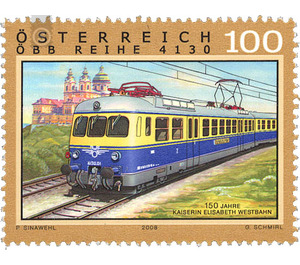railroad - Austria / II. Republic of Austria 2008 - 100 Euro Cent
Theme: Traffic, Transportation & Mobility
| Country | Austria / II. Republic of Austria |
| Issue Date | 2008 |
| Face Value | 100.00 |
| Edition Issued | 500,000 |
| Printing Type | combination printing |
| Stamp Type | Commemorative |
| Item Type | Stamp |
| Chronological Issue Number | 2098 |
| Chronological Chapter | OOS-OE2 |
| SID | 471714 |
| In 62 Wishlists | |
The original as k. k. Privileged Empress Elisabeth Railway designated Austrian West Railway runs from Vienna via Linz to Salzburg, and in a wing range from Wels to Passau. Although at that time the connection Vienna - Salzburg compared to the north-south connections was relatively insignificant, already in 1851 in a state contract between Bavaria and Austria a railway connection was agreed - above all, in order to allow the empress a quick and comfortable journey into their Bavarian homeland. The concession for the construction of this railway received a consortium around the industrial magnate Hermann Dietrich Lindheim. The route from Vienna Westbahnhof to Linz was opened on 15 December 1858, to Salzburg and on to Munich one could travel from August 1860. Due to the poor earnings of the Elisabeth Railway Company, the railway was nationalized in 1884. The Western Railway, which today is one of Austria's most important transport connections, alongside the Southern Railway, was already double-tracked between Vienna and Salzburg in 1902; Electrification began after the First World War from the west and was completed in 1952. Not least because of the EU enlargement, the importance has increased even more and since 1990 the Westbahn has been expanded into a partly four-track high-performance line; In the area of the Wienerwald, where the winding track has a mountain railway character, and the Tullnerfeld is a new building. The Vienna Wood Tunnel, which is currently under construction, will allow the trains to be routed directly to Vienna's main railway station, which is expected to be completed in 2015, which will allow further travel beyond Vienna without falling trains. After completing the finishing works, a journey from Vienna to Salzburg should be possible in two hours; In 1860 it took nine hours. The brand image shows the Swabian-Austrian parade train "Transalpin" traveling between Vienna and Basel on a stretch of road in front of Melk Abbey. For the train, which today is run by locomotive and wagons, ÖBB ordered its own railcar trains. Even before the acquired in 1965 six-unit trainset series 4010 1958 four four-car railcars of series 4130 were put into operation for this purpose. These came out of the 4030 series, but had more power, a higher top speed of 130 km / h and in the cab a kitchen.


